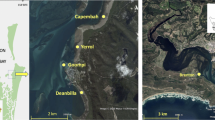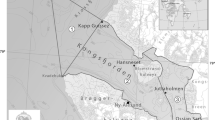Abstract
A series of 452 samples collected from November 1964 through February 1966 from a North Carolina sandy beach contained 27,219 invertebrates representing 41 species. The sandy-beach community, as composed of a homogeneous group of organisms, was identified through the use of an index of faunal affinity. Community structure is described in terms of abundance, frequency diversity, and feeding types. Six species,Neohaustorius schmitzi, Acanthohaustorius millsi, Donax variabilis, Scolelepis squamata, Exosphaeroma diminutum, andHaploscoloplos fragilis comprise 97% of the fauna by number. Niche differences among these species are discussed.
Similar content being viewed by others
Literature Cited
Bowers, D. E. 1964. Natural history of two beach hoppers of the genusOrchestoidea (Crustacea: Amphipoda) with reference to their complemental distributions.Ecology 45(4):677–696.
Coe, W. R., 1955. Ecology of the bean clamDonax gouldii, on the coast of southern California.Ecology 36(3):512–514.
Croker, R. A. 1967. Niche diversity in five sympatric species of intertidal amphipods (Crustacea: Haustoriidae).Ecol. Monogr. 37:173–200.
Dexter, D. M. 1967a. Population dynamics of the sandy-beach amphipodNeohaustorius schmitzi Bousfield. Ph.D. thesis, University of North Carolina.
— 1967b. Niche diversity of haustoriid amphipods in North Carolina.Chesapeake Sci. 8(3): 187–192.
Efford, I. E. 1965. Aggregation in the sand crabEmerita analoga.J. Anim. Ecol. 34:63–75.
Fager, E. F. 1963. Communities of organisms.In M. N. Hill (ed.) The Sea. Vol. 2:415–437.
Fox, D. L., 1950. Comparative metabolism of organic detritus by inshore animals.Ecology 31(1): 100–108.
Macfadyen, A. 1954. The invertebrate fauna of Jan Mayen Island (East Greenland).J. Anim. Ecol. 23:261–267.
McDougal, K. D. 1943. Sessile marine invertebrates of Beaufort, North Carolina.Ecol. Monogr. 13:322–374.
Pearse, A. S., H. J. Humm, andG. W. Wharton. 1942. Ecology of sand beaches at Beaufort, North Carolina.Ecol. Monogr. 12:136–190.
Raymont, J. E. G. 1955. The fauna of an intertidal mud flat.Deep Sea Res. 3 (Suppl.):178–203.
Sanders, H. L. 1960. Benthic studies in Buzzards Bay. III. The structure of the soft-bottom community.Limnol. Oceanogr. 5(2):138–153.
— 1968. Marine benthic diversity: A comparative study.Amer. Nat. 120:243–282.
Smith, J. E. 1932. The shell gravel deposits, and the infauna of the Eddystone Grounds.J. Mar. Biol. Assoc. U.K. 18(1):243–278.
Author information
Authors and Affiliations
Rights and permissions
About this article
Cite this article
Dexter, D.M. Structure of an intertidal sandy-beach community in North Carolina. Chesapeake Science 10, 93–98 (1969). https://doi.org/10.2307/1350837
Issue Date:
DOI: https://doi.org/10.2307/1350837




